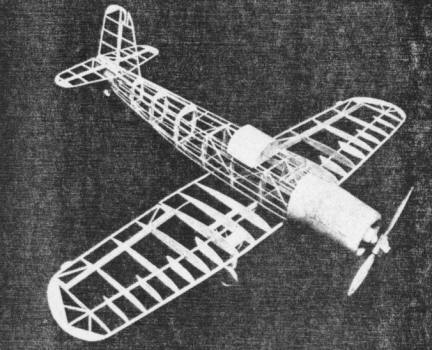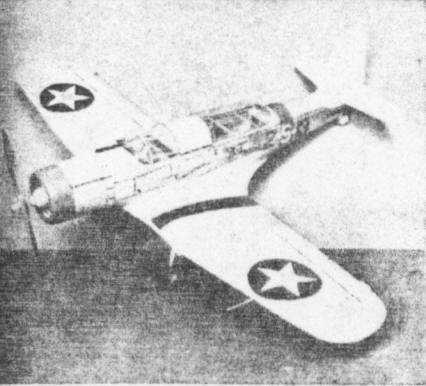|
Building the Vought Navy Scout Bomber by PAUL W. LINDBERG POPULAR AVIATION.
THIS is the latest type scout bomber developed for the Navy, and we know you will praise it highly. We consider our model for this month very attractive due to the great amount of detail together with its distinctive markings. It has proven an excellent flyer because of the large amount of wing surface. COLOR SCHEME Fuselage - gray and silver with green band. CONSTRUCTION OF FUSELAGE It is necessary to place a sheet of ordinary wax paper over the plan to prevent cement from sticking to the plan. Now you are ready to build the fuselage which is constructed one side it a time. The longerons, vertical and diagonal braces, etc., are held in place until securely cemented. This is done by inserting straight pins on either side of strips. When fuselage sides are completed, they are pinned to top view of the plan: in such a manner, that the top longerons face down and the sides are at right angles with the table. The cross-members are now cemented in place forming a rectangular fuselage. Cut formers from 1/32-inch sheet balsa and cement in their respective positions as shown on plan. CONSTRUCTION OF MOTOR The cylinders are carved and sanded from balsa blocks. When fourteen cylinders have been formed; to represent fins, wind heavy thread around them. Make crankcase from two pieces of balsa. Rocker arm housings, push rods and other small details of motor are made of balsa. CONSTRUCTION OF WING This wing is made up of two separate panels. Cut all ribs from 1/16-inch balsa. Pin the spar in position on the plan. Now, cement ribs in their proper locations. The leading and trailing edges are cut and sanded to shape and cemented to the ribs. The panels carry movable ailerons which are a great help in controlling the flights. Make wing tips from 1/16-inch thick balsa. We highly approve of this type of wing tip, because it is much easier to construct and neater in appearance. CONSTRUCTION OF ELEVATOR AND RUDDER These are built from 1/16-inch square and flat balsa and are constructed on the plan. Their construction is very simple, therefore, no trouble should result here. CONSTRUCTION OF LANDING GEARS The construction of landing gears is clearly shown on plan. COVERING THE MODEL Apply tissue to the various framework members using a light grade model airplane dope to fasten it to the outer edges. Stretch tissue as tightly as possible to remove all wrinkles. When edges have dried, apply coat of water to tissue. After water has dried completely, tissue will become taut. May we suggest that you pin wings, elevator and such to flat surface. This method prevents warping. ASSEMBLY After the wing panels have been cemented to fuselage, make fillets front paper and fill in open spaces between fuselage and wing panels at trailing edges. Other small details are clearly shown on plan. TESTING AND FLYING Two types of propellers are used on this model. One has a wide blade and blade is made of fiber. This type of blade causes the motor to turn at less r p.m. and greater flights result. By twisting the blades, the pitch can easily be adjusted. The balsa scale propeller is used for exhibition purposes only. Six strands of 1/8 flat rubber are sufficient to fly the model. With the rubber motor and flying propeller in place, gently launch your model over tail grass. By this method, you can see if your model is properly balanced. If model glides a short distance, and nose rises abruptly, it will be necessary to add weight to bottom of nose block. If model dives, add weight to tail. After the model is balanced to glide on an even angle, you are ready to test your model under power. In making test flight, the principal thing to avoid is damage to your model. Gliding and flying it over tall weeds is the safest, because the weeds or tall grass break the fall gently in case that the model should stall or dive. A few trial flights will acquaint you with the ship, and all other adjustments can be made through the adjustable control surfaces. Scanned From Popular Aviation |

